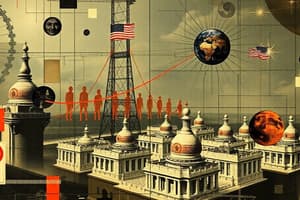Podcast
Questions and Answers
How is 'affect' best understood in relation to algorithms?
How is 'affect' best understood in relation to algorithms?
- As a static emotional response, directly caused by the algorithm's actions.
- As a predetermined set of rules, dictating how algorithms process emotions.
- As a form of logical calculation, inherent in the algorithm's design.
- As fluid moods and intensities, resulting from interactions with algorithms. (correct)
What does the text suggest about the location of an algorithm's 'doing'?
What does the text suggest about the location of an algorithm's 'doing'?
- It is exclusively contained within the coded instructions of the algorithm.
- It is found within the domain of public articulation, experience, and contestation. (correct)
- It is primarily determined by the user's existing emotional state.
- It is solely dependent on the technical specifications and hardware performance.
What key inquiry about algorithmic intensification is highlighted in the text?
What key inquiry about algorithmic intensification is highlighted in the text?
- The economic advantages of widespread algorithmic adoption in society.
- The technical challenges of improving the efficiency and speed of algorithms.
- The possibilities for coexisting with algorithms considering the forces of encounter they generate. (correct)
- The potential for algorithms to eliminate human biases and improve decision-making.
Which of the following best represents the 'Cathedral of Computation' analogy?
Which of the following best represents the 'Cathedral of Computation' analogy?
What does the text imply about algorithms' influence on an individual's sense of self?
What does the text imply about algorithms' influence on an individual's sense of self?
What is the primary function of supervised machine learning?
What is the primary function of supervised machine learning?
Why might the process of creating an annotated dataset for machine learning be considered 'extraordinarily expensive'?
Why might the process of creating an annotated dataset for machine learning be considered 'extraordinarily expensive'?
According to Bishop, what is the primary nature of our supposedly algorithmic culture?
According to Bishop, what is the primary nature of our supposedly algorithmic culture?
According to the information provided, what is a significant risk associated with the data used to train AI systems?
According to the information provided, what is a significant risk associated with the data used to train AI systems?
What role does Amazon Mechanical Turk play in the development of machine learning?
What role does Amazon Mechanical Turk play in the development of machine learning?
What does Bishop mean by 'algorithmic lore'?
What does Bishop mean by 'algorithmic lore'?
Which of the following is a key distinction between supervised and unsupervised machine learning?
Which of the following is a key distinction between supervised and unsupervised machine learning?
What is a focus of Bishop's analysis of algorithmic lore?
What is a focus of Bishop's analysis of algorithmic lore?
What is meant by the phrase 'registry of power' in the context of AI, as Crawford argues?
What is meant by the phrase 'registry of power' in the context of AI, as Crawford argues?
What is the main aim of algorithmic experts on platforms like YouTube?
What is the main aim of algorithmic experts on platforms like YouTube?
What does the text suggest about the trustworthiness of YouTube creators trained by algorithmic experts?
What does the text suggest about the trustworthiness of YouTube creators trained by algorithmic experts?
How does the provided information describe the relationship between machine learning and artificial intelligence?
How does the provided information describe the relationship between machine learning and artificial intelligence?
Considering that AI systems are trained on existing data, what would be the outcome of an AI model that is trained mostly on images of light skinned people?
Considering that AI systems are trained on existing data, what would be the outcome of an AI model that is trained mostly on images of light skinned people?
What is the primary use of urban algorithms according to the text?
What is the primary use of urban algorithms according to the text?
What is the potential negative consequence of urban algorithms, according to the text?
What is the potential negative consequence of urban algorithms, according to the text?
What was a key internal debate within NTechLab regarding the use of their facial recognition technology?
What was a key internal debate within NTechLab regarding the use of their facial recognition technology?
What is a key characteristic of platform-independent media?
What is a key characteristic of platform-independent media?
How have traditional news producers transitioned towards platform dependency?
How have traditional news producers transitioned towards platform dependency?
What distinguishes super apps like WeChat or KakaoTalk from typical single-purpose apps?
What distinguishes super apps like WeChat or KakaoTalk from typical single-purpose apps?
What is a key change regarding the platforms that games are dependent upon, according to the text?
What is a key change regarding the platforms that games are dependent upon, according to the text?
What is one way that creators on platforms like YouTube are affected by the platform?
What is one way that creators on platforms like YouTube are affected by the platform?
How do platforms like LINE create new cultural commodities using user content?
How do platforms like LINE create new cultural commodities using user content?
What is the main point made about the study of platforms?
What is the main point made about the study of platforms?
What can be said about the cultural production of journalists and news platforms?
What can be said about the cultural production of journalists and news platforms?
What was a key strategy employed by gig platforms to rapidly expand and gain market share?
What was a key strategy employed by gig platforms to rapidly expand and gain market share?
How did gig platforms primarily justify their exemption from traditional industry and sector-specific regulations?
How did gig platforms primarily justify their exemption from traditional industry and sector-specific regulations?
What was the primary initial reaction among policymakers to the rise of gig platforms?
What was the primary initial reaction among policymakers to the rise of gig platforms?
Why did food delivery and domestic cleaning services not face similar levels of institutional resistance as transportation and hospitality services when gig platforms emerged?
Why did food delivery and domestic cleaning services not face similar levels of institutional resistance as transportation and hospitality services when gig platforms emerged?
What did a specific gig platform do, to build community and keep their contractors engaged?
What did a specific gig platform do, to build community and keep their contractors engaged?
According to Vallas and Schor, what is a key characteristic of platform firms?
According to Vallas and Schor, what is a key characteristic of platform firms?
What does the term 'permissive potentates' as applied to platform firms by Vallas and Schor imply?
What does the term 'permissive potentates' as applied to platform firms by Vallas and Schor imply?
Which of the following best describes the allocation of power in the gig economy, as described in the text?
Which of the following best describes the allocation of power in the gig economy, as described in the text?
What is a key method through which platform firms profit according to the content?
What is a key method through which platform firms profit according to the content?
What does the text suggest about the nature of worker autonomy within the gig economy?
What does the text suggest about the nature of worker autonomy within the gig economy?
What is one of the consequences of platform models on workers?
What is one of the consequences of platform models on workers?
Based on the text, how do platform firms handle costs and risks commonly borne by employers?
Based on the text, how do platform firms handle costs and risks commonly borne by employers?
What does the author of this text mean by stating that platforms create 'unstable and precarious labor arrangements'?
What does the author of this text mean by stating that platforms create 'unstable and precarious labor arrangements'?
Flashcards
What is Algorithmic Affect?
What is Algorithmic Affect?
Algorithmic affect refers to how algorithms influence people's emotions and feelings, and vice versa.
Forces of Encounter
Forces of Encounter
Understanding how algorithms affect us requires examining the 'forces of encounter' - how algorithms interact with and influence our experiences.
How Algorithms Are Shaped by Perception
How Algorithms Are Shaped by Perception
The way we perceive and interpret algorithms, including their social and ethical implications, shapes their performance and impact.
Moral Panic
Moral Panic
Signup and view all the flashcards
The Cathedral of Computation
The Cathedral of Computation
Signup and view all the flashcards
Algorithmic Culture
Algorithmic Culture
Signup and view all the flashcards
Algorithmic Lore
Algorithmic Lore
Signup and view all the flashcards
Urban Algorithm
Urban Algorithm
Signup and view all the flashcards
Power of Algorithm Control
Power of Algorithm Control
Signup and view all the flashcards
Algorithmic Optimism
Algorithmic Optimism
Signup and view all the flashcards
Algorithmic Optimism
Algorithmic Optimism
Signup and view all the flashcards
Algorithmic Experts
Algorithmic Experts
Signup and view all the flashcards
Algorithm-Based Authority
Algorithm-Based Authority
Signup and view all the flashcards
What is Artificial Intelligence (AI)?
What is Artificial Intelligence (AI)?
Signup and view all the flashcards
What is Machine Learning (ML)?
What is Machine Learning (ML)?
Signup and view all the flashcards
What is Supervised Machine Learning?
What is Supervised Machine Learning?
Signup and view all the flashcards
What is Unsupervised Machine Learning?
What is Unsupervised Machine Learning?
Signup and view all the flashcards
What is the role of data in AI systems?
What is the role of data in AI systems?
Signup and view all the flashcards
Why is data annotation important for AI?
Why is data annotation important for AI?
Signup and view all the flashcards
How can biases be encoded in AI systems?
How can biases be encoded in AI systems?
Signup and view all the flashcards
What is crowdsourcing in AI?
What is crowdsourcing in AI?
Signup and view all the flashcards
Move Fast and Break Things
Move Fast and Break Things
Signup and view all the flashcards
Platform Exceptionalism
Platform Exceptionalism
Signup and view all the flashcards
Industry Resistance to Platforms
Industry Resistance to Platforms
Signup and view all the flashcards
Economic Empowerment Narrative
Economic Empowerment Narrative
Signup and view all the flashcards
Informal Sector Advantage
Informal Sector Advantage
Signup and view all the flashcards
Platform-independent content
Platform-independent content
Signup and view all the flashcards
Platform-dependent content
Platform-dependent content
Signup and view all the flashcards
Platformization
Platformization
Signup and view all the flashcards
Super Apps
Super Apps
Signup and view all the flashcards
Regional particularities of platforms
Regional particularities of platforms
Signup and view all the flashcards
Journalism and Platform Dependence
Journalism and Platform Dependence
Signup and view all the flashcards
Independent Online News Outlets
Independent Online News Outlets
Signup and view all the flashcards
Cultural Production in Platform Ecosystems
Cultural Production in Platform Ecosystems
Signup and view all the flashcards
What is a platform firm's hybrid nature?
What is a platform firm's hybrid nature?
Signup and view all the flashcards
How do platforms exert control while appearing decentralized?
How do platforms exert control while appearing decentralized?
Signup and view all the flashcards
How do platforms benefit from a dispersed workforce?
How do platforms benefit from a dispersed workforce?
Signup and view all the flashcards
What are the driving forces behind the gig economy's emergence?
What are the driving forces behind the gig economy's emergence?
Signup and view all the flashcards
What is the scope and methodology of the research project?
What is the scope and methodology of the research project?
Signup and view all the flashcards
How does the research capture the experiences of gig workers?
How does the research capture the experiences of gig workers?
Signup and view all the flashcards
How does the research contribute to understanding the gig economy's wider implications?
How does the research contribute to understanding the gig economy's wider implications?
Signup and view all the flashcards
What is the core tension within the gig economy?
What is the core tension within the gig economy?
Signup and view all the flashcards
Study Notes
Algorithms and Fictions
- Algorithms are sets of rules for calculations and problem-solving, often used by computers.
- Public perception of algorithms is strong, but they also have real socio-technical aspects that can be studied.
- Public opinion about algorithms matters as much as their function.
- Generative AI and foundation models are complicated and exacerbate previous understanding.
- Algorithms are defined as step-by-step processes, such as those employed by YouTube.
- Algorithmic systems sort, manipulate, and predict.
- Public perception of algorithms has an affective dimension.
- Opaqueness leads to a need to visualize algorithms.
- People create narratives around algorithms.
- Twitter and Facebook were researched to understand public perception of algorithms.
- Reactions to algorithms were scrutinized for any patterns in people's understanding.
Algorithmic Affect
- Algorithms affect mood and intensity.
- Personal narratives about algorithms demonstrate that understanding them goes beyond mere code.
- Algorithms are not only "in" the code but are performed and contested through public discourse.
- Algorithms' role in everyday life warrants consideration of their affective impact.
- Considering how algorithms evoke feelings is essential to understanding their effects.
- Public perception, and how these feelings influence the logic of the system, is critical.
Algorithmic Lore
- Algorithmic experts and lore are a mix of data-informed opinions and subjective narratives.
- YouTube motivational speakers/influencers are experts in algorithmic lore.
- Algorithmic experts attempt broad generalizations, often ignoring specific audience data.
- Emphasis on gendered performance during generalization might obscure important data.
- Expert training usually aligns with YouTube's platform trends, disregarding systemic issues.
Urban Algorithms
- Urban algorithms refer to computational rules that analyze, manage, or optimize urban environments.
- These algorithms are employed in various urban aspects, such as planning, transportation, and infrastructure.
- Algorithms analyze data to improve urban dynamics (traffic, population patterns, etc)
- Optimizing efficiency, sustainability, and quality of life are key goals of algorithms.
Generative AI (Neural Networks)
- Neural networks resemble the human brain in structure and processing.
- Layers of interconnected nodes (neurons) in a neural network handle data processing.
- Neural networks are often used in machine learning for tasks like image and speech recognition.
- Adjusting connections ("weights") is how neural networks improve with time.
- Tokenization is the division of text into smaller units.
- Identifying characters, words, or phrases are methods of tokenization.
- Language structure, meaning, and context analysis is easier with tokenization.
Post-Training Alignment (Weights)
- Pre-trained AI models are fine-tuned using techniques like reinforcement learning from human feedback.
- This fine-tuning aligns the model with human values and desired behavior.
- This ensures appropriate responses in real-world applications.
- Backpropagation is a type of adjustment used for alignment.
- Scale of resources used (compute power, dataset size, etc.) exponentially increases with larger models.
Foundation Models
- Large-scale AI models trained on extensive data are "foundation models".
- Foundation models are adaptable to many applications, with little additional fine-tuning required.
- They benefit from training on diverse data.
- Foundation models are versatile across various applications.
AI and Discrimination
- Classification in machine learning is a historical practice connected to discrimination.
- Contemporary classification systems reproduce bias.
- Different processes (including AI, machine learning, and algorithms) are often confused.
- Understanding these processes is crucial.
- Examples of how classification and bias can emerge include the Home Owners Loan Corporation and its policies.
- Redlining is a discriminatory practice that denies services to certain communities, often racial minorities.
- The Home Owners Loan Corporation (HOLC) used subjective judgments to create segregation maps.
Content Moderation and Digital Labor
- Content Moderation: The process of monitoring, reviewing, and potentially controlling social media content.
- Soft Moderation: The reviewing of social media content that is typically done by humans.
- Hard Moderation: Algorithmic methods used to filter and classify content.
- Moderation on social media platforms is often performed by a globally distributed workforce at very low wages.
- Factors influencing business models for content moderation include policy pressure, legal requirements, business interests, and societal expectations.
- Transparency within content moderation affects who’s accountable.
- Companies use metrics and feedback from users to measure the effectiveness of their moderation systems.
Platform Labor
- Platform labor encompasses jobs facilitated by digital platforms.
- Workers on these platforms are typically contract workers, not employees.
- Various worker types fall under this category, including creators, online gig workers, and app-based gig workers.
- There are ethical concerns related to the working conditions for those who work on platforms.
- Platform workers are motivated through incentives like bonus pay, referral bonuses, and hourly/piece-rate wages.
Ecology
- Ecology: The interrelations of living things with their environment.
- Technology's impact on the environment is a primary concern.
- Methods for mining resources are examples of large-scale environmental effects.
- Production and processes behind modern technology (media, etc.) have environmental consequences.
- Data centres consume significant resources and energy.
- The impact of data centers on the environment and physical reality.
Advertising Platforms
- Advertising platforms employ resource-intensive machine learning for personalization.
- Marketing campaigns are designed to create a cycle of obsolescence in advertising.
Studying That Suits You
Use AI to generate personalized quizzes and flashcards to suit your learning preferences.




